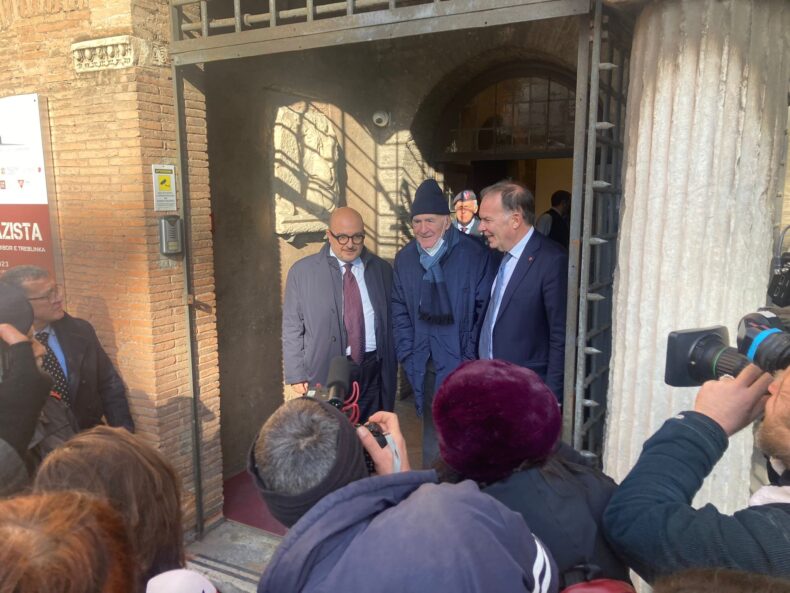Aktion Reinhardt, an exhibition depicts the horror

Aktion Reinhardt, the Nazi plan that murdered about 1.7 million Jews and an unknown number of Poles, Roma, and Soviet prisoners of war in German-occupied Poland, is the focus of a new exhibition by the Museum of the Shoah Foundation recently inaugurated in Rome. Titled “The Nazi hell. The death camps of Belzec, Sobibor, and Treblinka”, the exposition, curated by historian Marcello Pezzetti, was conceived on the anniversary of the uprising of the Warsaw Ghetto and the riots that took place in Sobibor and Treblinka to recount a murderous operation “which has no precedent in any type of civilization”.
With this project, as the Museum president Mario Venezia remarked in presenting it, “the Foundation reconstructs and analyzes with dutiful scrupulousness the project of mass extermination in specially built camps. In those camps, exactly eighty years ago, numerous groups of prisoners found the courage and strength to trigger revolts against their torturers. We hope that this historical exhibition will reach significant audiences, because we believe that study and research are indeed the healthiest form of rebellion”.
As pointed out Pezzetti, other groups and categories were persecuted beyond Jews. Despite this, emphasis must be placed on “the specificity of the Shoah: the largely successful attempt to physically eliminate part of its population, and then the entire population of occupied Europe, employing in this genocide all the forces of the state”. Aimed at “restoring a decent memory to what unfortunately happened, in favor of a general public”, the exhibition revolves with scientific rigorousness around different themes.
Starting from the operation’s geographical and historical context, the display explores the use of gas as a mass extermination instrument, from the T4 Aktion against the disabled to the death camps established in the so-called General Government. The institution of Nazi ghettos is then recounted, with a particular look at the process of ghettoization and topics such as their institution, the entry into these segregated areas, and the construction of the wall surrounding them. The story of the liquidation of the ghettos is then illustrated, illuminating through a wide selection of images and a video station the passage from life to death and the deportations to extermination camps.
 An entire hall of the exhibition is dedicated to Aktion Reinhardt and its places (the extermination camps of Belzec, Sobibor, and Treblinka). This section explains how Polish Jews and some German, Austrian, Slovak, Belarusian, Lithuanian, French, Dutch, Thrace, and Macedonian Jews, as well as those from the Theresienstadt ghetto and the Bohemia Protectorate and Moravia, were put to death. The statistics of the operation, the figures of the victims, and the structure of the three extermination camps are provided, with an additional focus on that of Majdanek. Nazi persecutors and their collaborators are the focus of the next room, where the riots in the Sobibor and Treblinka camps are discussed with a hint about the Jewish resistance in Eastern Europe.
An entire hall of the exhibition is dedicated to Aktion Reinhardt and its places (the extermination camps of Belzec, Sobibor, and Treblinka). This section explains how Polish Jews and some German, Austrian, Slovak, Belarusian, Lithuanian, French, Dutch, Thrace, and Macedonian Jews, as well as those from the Theresienstadt ghetto and the Bohemia Protectorate and Moravia, were put to death. The statistics of the operation, the figures of the victims, and the structure of the three extermination camps are provided, with an additional focus on that of Majdanek. Nazi persecutors and their collaborators are the focus of the next room, where the riots in the Sobibor and Treblinka camps are discussed with a hint about the Jewish resistance in Eastern Europe.
The most important room is dedicated to Treblinka. Here an immersive section presents a reconstruction of the camp, along with a sequence of videos and audios accompanied by the narrative voice of the actor Luca Ward. Scans of the original maps made by Nazis and survivors are on display, along with pictures of deportations, mass graves, and burning of corpses, the entire photo album of Kurt Franz, pictures of the dismantling of the camp, and photos of Treblinka nowadays.
The exhibition continues with a room dedicated to the end of Aktion Reinhardt: the dismantling of the three camps and those responsible for the largest mass extermination in history transferred to Italy’s Adriatic. Here they went to arrest and deport the Jews residing in the area (Udine, Gorizia, Trieste, and Fiume) and thousands of non-Jews, mainly political opponents. The exhibition itinerary ends with a space dedicated to the fate of Nazi criminals.
“Nazi hell. The death camps of Belzec, Sobibor, and Treblinka” is realized with the patronage of the Presidency of the Council of Ministers, the Ministry of Culture, the Ministry of Foreign Affairs and International Cooperation, the UNAR National Office for Racial Anti-Discrimination, Lazio Region, Roma Capitale, UCEI-Union of Italian Jewish Communities, the CER Jewish Community of Rome, the Sons of the Shoah Association, the CDEC Center for Contemporary Jewish Documentation, and ANED-National Association of Former Deportees to Nazi Camps.
From top, Holocaust survivor and witness Sami Modiano with the Minister of Culture Gennaro Sangiuliano and the President of the Museum of the Shoah Mario Venezia; the curator Marcello Pezzetti.
